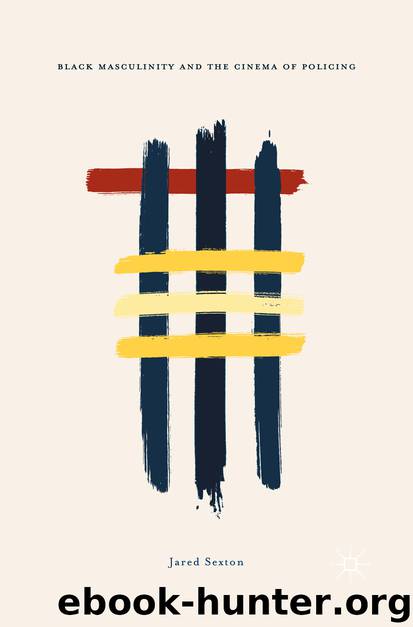Black Masculinity and the Cinema of Policing by Jared Sexton

Author:Jared Sexton
Language: eng
Format: epub
Publisher: Springer International Publishing, Cham
The new carceral mesh highlights a certain stalling out of the historical evolution of racial domination in response to novel challenges across the nineteenth and twentieth centuries. Jim Crow casts a net around the recently emancipated, generalizing the badge of slavery throughout the Southern region in the wake of Reconstruction. As black people migrate en masse beyond regional boundaries, the formation of the urban ghetto maintains, and in ways deepens, the fundamental relations they sought to escape. The prison then plays the role of fail-safe, as the strict confinement of the ghetto begins to reveal its limitations. Now, the regime of mass imprisonment itself, including especially the predations of antiblack police violence, has begun to suffer a crisis of legitimacy, posing again the question of what new institutional forms might rise to the occasion.
But the fourth peculiar institution also announces a departure from the previous three, “in accordance with the dictates of the deregulated economy and the post-Keynesian state.” Whereas “America’s first three ‘peculiar institutions’… were all instruments for the conjoint extraction of labor and social ostracization of an outcast group deemed unassimilable” (42), the racial domination of today “does not carry out a positive economic mission of recruitment and disciplining of the workforce: it serves only to warehouse the precarious and deproletarianized fractions of the black working class” (53). Put somewhat differently, that warehousing is the predominant form that social ostracism now takes. Given that the positive economic function of the previous four centuries could fall away without dismantling the equally persistent reproduction of stigma—if anything it has enhanced it—demonstrates that the latter function is in fact most essential to this history; that is to say, the derivation of symbolic value from the condemnation of black social status. If that symbolic value coincides with windfalls of profit or the long-term accumulation of capital, so be it. At any rate, it appears that the dynamics of the capitalist system cannot proceed apace unless its symbolic economy of anti-blackness remains operative within a parameter. This is no less true for the capitalist enterprise of professional football and its widespread representation in the multimedia culture industry.
John Lee Hancock’s The Blind Side (2009) grossed over $300 million at the international box office on a modest $30 million budget and it garnered a host of awards, including the Oscar and the Golden Globe, for lead actress Sandra Bullock. In fact, The Blind Side became the most successful sports drama in Hollywood history. It follows Michael Oher’s improbable rise from the Memphis public housing and foster care systems to his All-American football career at the nearby University of Mississippi to his professional employment for the Baltimore Ravens, with whom he went on to win a Super Bowl Championship. The Blind Side is often read as a feel-good story extolling the virtues of athletics-as-uplift, in which the likely fate of a poor black urban youth is redirected by the intervention of a professional white woman and the institutional resources she accesses and affords, including a pathway to organized sports.
Download
This site does not store any files on its server. We only index and link to content provided by other sites. Please contact the content providers to delete copyright contents if any and email us, we'll remove relevant links or contents immediately.
| African-American Studies | Asian American Studies |
| Disabled | Ethnic Studies |
| Hispanic American Studies | LGBT |
| Minority Studies | Native American Studies |
Cecilia; Or, Memoirs of an Heiress — Volume 1 by Fanny Burney(32434)
Cecilia; Or, Memoirs of an Heiress — Volume 2 by Fanny Burney(31871)
Cecilia; Or, Memoirs of an Heiress — Volume 3 by Fanny Burney(31854)
The Great Music City by Andrea Baker(31349)
We're Going to Need More Wine by Gabrielle Union(18967)
All the Missing Girls by Megan Miranda(15570)
Pimp by Iceberg Slim(14393)
Bombshells: Glamour Girls of a Lifetime by Sullivan Steve(13972)
Talking to Strangers by Malcolm Gladwell(13222)
Norse Mythology by Gaiman Neil(13204)
Fifty Shades Freed by E L James(13157)
For the Love of Europe by Rick Steves(12983)
Mindhunter: Inside the FBI's Elite Serial Crime Unit by John E. Douglas & Mark Olshaker(9200)
Crazy Rich Asians by Kevin Kwan(9167)
The Lost Art of Listening by Michael P. Nichols(7406)
Enlightenment Now: The Case for Reason, Science, Humanism, and Progress by Steven Pinker(7231)
The Four Agreements by Don Miguel Ruiz(6630)
Bad Blood by John Carreyrou(6552)
Weapons of Math Destruction by Cathy O'Neil(6143)
